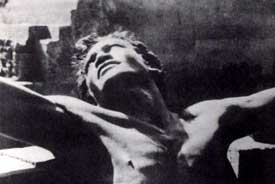 Throughout North America & Europe, it was well known that in Bali, women of all ages went bare breasted. Balinese women became international pin-up girls, especially in the United States where the sexploitation film genre called "nudie cuties" were apt to be confiscated by the feds if shipped through the mails, but aboriginal women didn't have the same level of censorship.
Throughout North America & Europe, it was well known that in Bali, women of all ages went bare breasted. Balinese women became international pin-up girls, especially in the United States where the sexploitation film genre called "nudie cuties" were apt to be confiscated by the feds if shipped through the mails, but aboriginal women didn't have the same level of censorship.
There has always been something racist in treating aboriginal peoples like the moral equivalent of water buffalo who weren't expected to wear clothes. This form of racism or cultural chauvenism comingled with a notorious American prudery that found nudity shocking to the point that it was frequently legislated against.
This all resulted in it being okay if National Geographic ran pictures of nekkid ladies of Kenya or Fiji or Bali, just as long as they weren't "civilized" by western definition. And many an adolescent male deprived of a Sears catalog with plenty of pictures of girls in their underclothes would rely on National Geographic photos when in the mood to fiddle-dee-day.
In the early 1930s several exploitation films were concocted from travel footage of Bali. The defining example was Goona Goona: An Authentic Melodrama of the Isle of Bali (aka, The Kris; or, The Kris: Sword of Death; or Love Powder; or, Man's Paradise,1932), co-directed by Franklin D. Roosevelt's far-removed-distant cousin Andre Roosevelt.
It was advertised as a tale of "witchcraft & the sensuous charms of savage sirens." The first film of the type was in the silent era, Calan Arang (1927) advertised as a tale of witchcraft, a kris, & "dusky beauties." But that one does not survive, & Goona Goona with the same "plot" elements imposed on travel footage was the first such film to become wildly popular.
Two versions exist, a 45 minute re-release "cleaned up" by Al Friedlander to avoid censorship, & its original 70 minutes complete. It was originally in two-strip technicolor, & was the last film with unsynchronized sound. Travel footage was edited in such a manner as to imply a story & the narrator trumped up a tale of a Balinese prince who fell in love with a mere servant, but she marries a youth of her own caste.
His prince's witchy sister drugs the poor girl with goona-goona in her food, & the prince rapes her while she's under the drug's influence, leaving her the gift of a ceremonial knife. When the girl's husband finds this knife he knows instantly what it means, resulting in a sexy duel to the death between the two beautiful young men.
The "actors" are not professionals but do a good job. The bare-breasted girls giggle about the antics which the dufus filmmakers from America have instructed them to do. The girls giggle even in the serious parts. The young men are taking their roles more seriously.
The film insinuates that Balinese girls can be as lusty as they desire before marriage, but once married, offenses to her honor can be cause for extreme tragedy. I somehow doubt the film is ethnographically valid, but reflects American beliefs about Polynesia generally, dating back to the early writings of Herman Melville.
This film's use of the Royal Balinese Gamelon Orchestra impacted imitations which likewise strove for musical soundtracks of quality. The subject of the "goona goona," a love filtre, & the plethora of breasts, insured the sexploitation angle, while music & travelogue education angle kept the authorities willing to let it pass.
But what heterosexual viewers seem not to have noticed was this was also a film of considerable interest to the gay underground, with as much beefcake as breasts, & a climactic battle between the main lads that was viewed by those in the know as a sexual parallel. And death of men who commit homosexual acts was a cliche in underground literature between the 1930s & 1950s, so it all fit tidily into a contemporary gay expectation.
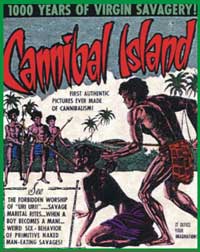 It was so successful at the box office that it set off a mini-explosion of exploitation documentaries of Bali. These included Balinese Love (1932), Isle of Paradise (1932), Legong: Dance of the Virgins (1935), Wajan (1937), & others. It was so successful at the box office that it set off a mini-explosion of exploitation documentaries of Bali. These included Balinese Love (1932), Isle of Paradise (1932), Legong: Dance of the Virgins (1935), Wajan (1937), & others.
The majority in emulation of Goona Goona were pseudo-documentaries with a thinly overlayed dramatic story awkwardly imposed on travel footage, though such no-budget tricks were not new to Goona Goona.
For example the first sexploitation & cannibal film Gow the Killer (aka, Cannibal Island, 1931) although scripted as a semi-fictional documentary incorporates travel footage of the E. A. Salisbury expedition to such islands as the Andamans, Fiji, Samoa, & the coast of New Guinea in the mid-1920s, the main fictional element of the film being set in the Solomons.
The term goona-goona referred to a Balinese aphrodisial narcotic, but trade magazines began calling these sorts of films "goona-goonas," inclusive of exotic-location exploitation films all around the world, such as Angkor (1937) & Jaws of the Jungle (1936) set in Cambodia & Sri Llanka respectively.
These influenced burlesque houses where the striptease artists added Polynesian exotica to their routines. With goona-goonas in the grindhouses & re-enacted on burlesque stages, the term slipped into general use as a synonym for the F word or anything unusual to do with sex.
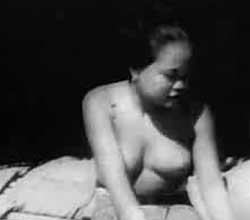 In the 1950s Joe Bonica had an especially profitable mail-order line of films called "Candids" which were pretty much the same as nudie-cuties. Bonica got the films from various sources & it's not clear which if any might actually have been produced by him as he claimed. Directors were anonymous, with dates usually unknown or uncertain.
In the 1950s Joe Bonica had an especially profitable mail-order line of films called "Candids" which were pretty much the same as nudie-cuties. Bonica got the films from various sources & it's not clear which if any might actually have been produced by him as he claimed. Directors were anonymous, with dates usually unknown or uncertain.
They were generally marketed as 8 mm or 16 mm three-minute to ten minute (one-reel) films for home projection. Very likely the short-short films were also sold to adult arcades who would include them in the film-loops of adults-only panorams.
Women of Bali (distributed 1950s though the footage probably dates to the 1930s) is a three-minute documentary of busty ladies at work among the palm trees & beaches of Bali. It was given a soundtrack of Hawaiian swing & no narration.
Symbolic pounding of palm hearts is especially valued by the cinematographer, in between close-ups of aboriginal boobies.
It scarsely looks pornographic by today's standards & really it never was, but that was its main purpose in days when the real thing could get a producer or a vendor arrested.
Joe Bonica produced (or recycled) a large number of these short-short silent films for guys who come quickly, available in the 1950s by "Movie of the Month" subscription, "disguised" more or less as newsreels which some of them were (& he did also repackage newsreel footage as educational family films, distinct from the so-called "candids").
The pictorial content of such films frequently possess enthnographic value, but the narrations are more about our own society's historical cultural values. And that lends them an intellectual interest as "Americana" beyond whatever other values they possess.
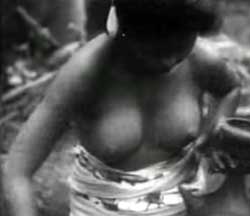 With an unexpectedly excellent score by Louis Betancourt's Marimba Orchestra, Virgins of Bali: Land of Love & Romance (1932) is a travel documentary with a semi-acted story, intent on making Polynesia more dream than actual location.
With an unexpectedly excellent score by Louis Betancourt's Marimba Orchestra, Virgins of Bali: Land of Love & Romance (1932) is a travel documentary with a semi-acted story, intent on making Polynesia more dream than actual location.
A "Cast of Natives" are named in the opening credits, Tagel the twelve year old girl played by Ni Wayan Tagel, Crio the sixteen year old girl played by Ni Wayan Ugembon, Kaler, Crio's boyfriend played by T. Kaler, & playing himself, native orchestra leader I. Maria.
Both girls, even the younger one who lends the film an unfortunate child molestation aspect, are shown topless most of the time, since the mores of the era somehow permitted a strong dose of nudity & erotica if it was "mere" aboriginal people. It would be a jailable offense to show the same degree of nudity of "civilized" women, let alone "civilized" children as sexually objectified as this film makes Polynesian girls.
If the title sounds exploitative, well duh. Films like this one would select shapely babes testing the limits of what could be fobbed off as "family" entertainment. Such films were sold on the 16 mm home projection market, so that in the privacy of homes this "family" film could be watched by dad when no one else was around, but it would not honestly be a raunchy film so would not lead to arrest or be taboo for family viewing. The marketability of such films would evaporate wherever actual softcore became available.
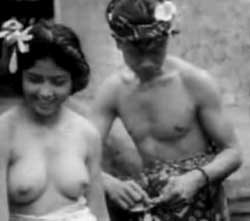 We're told "Crio & Tagel are the fairest flowers of a handsome race," & we follow them on a day-in-the-lives, grooming & dressing late in the morning, through "a land of beautiful women. They outnumber the men five to three." We're told "Crio & Tagel are the fairest flowers of a handsome race," & we follow them on a day-in-the-lives, grooming & dressing late in the morning, through "a land of beautiful women. They outnumber the men five to three."
The annoying narrator describes these two children's bodies in the most objectifying manner & the cinematographer delights in filming them stark naked, except for headdress, splashing in a drainage ditch. After a limb-by-limb horny discription of how clean they are (I wouldn't personally count of the ditchwater getting them clean), how white their features, how well built &almp lucious, the narrator concludes "They are the most beautiful brunettes in the whole world."
For modern viewing there's a certain dissonance between what really is innocent photography, vs this "travel" narrative which is just a little pervy. And it does make one wonder if Bali of the 1930s was a sex-trade destination for pedarasts like Thailand & Malay are today, as the film is just shameless in advertising & sexualizing these "clean" children.
Similarly today children are marketed in Southeast Asian countries as "clean," their alleged virginity being proof against AIDS. And as this is pure fabrication, so too had venereal diseases been "traded" with sailors as early as Captain Cook's expedition.
The reality was just as different in Bali. While western men soon made venereal disease an extreme commonplace in Bali, the Balinese returned the favor by spreading framboesia to sailors & sex tourists, a horrific skin disease spread by insects & by sexual intercourse which eventually attacked cartilege so that long-term sufferers could literally have their pharynx, pallat, & noses melt away.
Before such films became a commonplace, Bali had about 100 tourists each year arriving from the west. But after 1932's Goona Goona that number rose to two or three hundred per month, & increased each year, a great many being single men of nefarious purpose.
Shopping, eating, smoking, we are presented an all but manless society of breasts, breasts, breasts. Frequently in a given scene there'll be two, three, or a dozen pairs of boobs, & close-ups of individual women whose faces aren't as well lit & visible as their titties.
When first released, Variety magazine noted the ongoing commercial success of "bust pictures," & noted that its first showing on its premiere was a sell-out with narry a woman in the audience. Even in today's environment where outright pornography is easily accessed, this old film would still work nicely for breast fetishists.
When it does get 'round to showing Crio's boyfriend Kaler, he's a very young hunk & introduced thus: "As a small boy he was a famous dancer." In the international sex-trade involving children, boys really are as important as girls after all, thus objectified in terms of dancing boys with flowers in their hair. (And is why a gay niteclub in New York City in the late 1930s was named the Goona Goona.)
A bit of mummery is presented, alleging to be the elopement-marriage ritual, the fake hunt by the pretend-irate parents for the young lovers hiding in the woods for two nights of lustiness, because deflowering is done prior to the wedding. At last they return home to a huge feast & a marriage festival.
It builds toward a big dance & costume scene of dancing children, young teenage boys & girls. The music provided by "the famous gamilon orchestra" of I. Maria is not what we're hearing, but Louis Betancourt's Marimba Orchestra is trying to approximate an authentic sound.
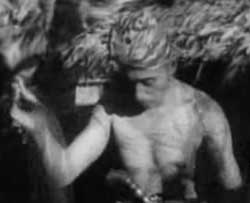 Perilous Paradise (1940s) is a one-reel film distributed by Official Films in 8 mm & 16 mm formats for home projection. Perilous Paradise (1940s) is a one-reel film distributed by Official Films in 8 mm & 16 mm formats for home projection.
It's a documentary of an "Indonesian" island the narrator calls Dikdavon or Tiktovan, it's impossible to tell, but clearly stated to be Indonesian & shown to be religiously Islamic. There are thousands of islands in the Malay-Indonesia archepalego & who knows if the one they barely named exists or was just made up to go with some nice cinematography of who-knows-where.
The narrator speaks of it as untouched by the modern world, though our first image of a street shows men in modern garments, one with a fez, by no means the primitives the narrator wants us to fantasize.
The town's architecture includes grass-thatch roofs, so it's very pretty. And for the moment this seems like it might be an actual attempt at showing Island life as it existed only a few decades past, rather than another of those "naked island babes" softcore films posing as documentaries to get past censors.
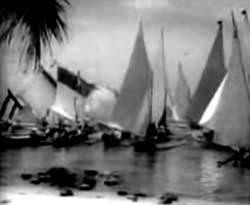 We see men, women, children, & the elderly, at work & play, studying the Koran, preparing bettle nut powder to chew & get stoned, fishing, boating, grooming, gathering coconuts, sword-dancing, bathing, much else, pretty regular stuff. We see men, women, children, & the elderly, at work & play, studying the Koran, preparing bettle nut powder to chew & get stoned, fishing, boating, grooming, gathering coconuts, sword-dancing, bathing, much else, pretty regular stuff.
There's a moment when we catch a glimpse of a cigar-smoking dwarf atop an elephant clearly a man of some distinction, but we never learn more about him. A troupe of entertainers (spear fighters, dancers, fire-eater, & so on) seem to be present to entertain this fellow.
Mainly a silent film except for the narration, now & then the musical soundtrack inserts a bit of native music intended to match what's happening on screen, but it seems never to be from the same source or day as the film.
The "perilous" aspect begins more than halfway through the film when we see pearl divers allegedly at risk of being caught as in beartraps by giant oysters, or assaulted by manatees described as "malignant, evil, an apparition from the unknown."
In reality the manatees were completely docile. A scene is faked with participation of the pearl divers in that one of them pretends to be caught by a deadly giant oyster with a shark descending upon him, saved by a fellow diver in the nick of time.
It's a wonderfully phony sequence & it's fun to see the divers enjoying the pretense. We even get to see a brave man fight the shark with just an oyster knife, obviously having fun trying to make it look dangerous.
It closes with some lovely pastoral images of jungle & sea, while the narrator gives us a poem of the Zamboanga which wasn't that bad a poem, though Zamboanga is the western portion of Mindanao the second largest island of the the Philippines & has nothing to do with Islamic Indonesia.
copyright © by Paghat the Ratgirl
|


 It was so successful at the box office that it set off a mini-explosion of exploitation documentaries of Bali. These included Balinese Love (1932), Isle of Paradise (1932), Legong: Dance of the Virgins (1935), Wajan (1937), & others.
It was so successful at the box office that it set off a mini-explosion of exploitation documentaries of Bali. These included Balinese Love (1932), Isle of Paradise (1932), Legong: Dance of the Virgins (1935), Wajan (1937), & others.

 We're told "Crio & Tagel are the fairest flowers of a handsome race," & we follow them on a day-in-the-lives, grooming & dressing late in the morning, through "a land of beautiful women. They outnumber the men five to three."
We're told "Crio & Tagel are the fairest flowers of a handsome race," & we follow them on a day-in-the-lives, grooming & dressing late in the morning, through "a land of beautiful women. They outnumber the men five to three."
 We see men, women, children, & the elderly, at work & play, studying the Koran, preparing bettle nut powder to chew & get stoned, fishing, boating, grooming, gathering coconuts, sword-dancing, bathing, much else, pretty regular stuff.
We see men, women, children, & the elderly, at work & play, studying the Koran, preparing bettle nut powder to chew & get stoned, fishing, boating, grooming, gathering coconuts, sword-dancing, bathing, much else, pretty regular stuff.